Early Office Museum
Vintage Office Photographs
~ 1908-1909 ~
When no date is provided in the Description column below, we
do not know the date of the photograph.
We have placed undated photographs in their likely chronological order.
Please do not use the Museum's photos without permission.
Unless a photo's Source is identified as "Early Office Museum
Archives," we do not have the ability to give permission to use that
photo.
When we see our
photos used on the internet without permission, we submit a complaint to Google and other search engines, which then stop
indexing the offending web site and stop placing advertising on it.
| Click Image to Enlarge | Description | Source |
 |
Man operating a Burroughs adding machine in front of a walk-in vault, Bank of Hickman, Hickman, NE. According to the website of First State Bank, the "Bank of Hickman conducted business in the Hickman area from approximately 1891-1912. In 1912 a state charter was granted to the bank and it became First State Bank." | Early Office Museum Archives |
 |
Office at Wisconsin Traction, Light, Heat & Power Co., 1908. The office was probably in Appleton, WI. The company was formed in 1900 by the acquisition of Fox River Valley Electric Co. and Appleton Electric Light & Power Co., and operated intraurban and interurban electric railways serving Neenah, Appleton, and Kaukauna. The intraurban Appleton streetcar system had begun in 1886. The interurban system had begun in 1898 with service between Neenah and Appleton. In 1927, Wisconsin Traction was renamed Wisconsin-Michigan Power Co., and in 1928 Interurban services ended.. Another photograph of this office shows that it contained a Burroughs adding machine. Dated by wall calendar. | Early Office Museum Archives |
 |
Bank with three men, an Oliver typewriter, a Burroughs adding machine, and a kerosene lamp. | Early Office Museum Archives |
 |
Bank with two men, a US Automatic pencil sharpener (introduced in 1907) and a Protectograph check protector on the counter at the left, a Burroughs adding machine in the center of the room, and a Cary Safe Co. vault in the rear. Internet references to Cary Safe Co. as a seller of safes date primarily to 1902-07. | Early Office Museum Archives |
 |
"Edison at his desk in the West Orange Library," West Orange, NJ, photograph by Pach Bros., New York, copyright 1908. Pach Bros. was operating as a New York photography company by 1886. | Edison National Historic Site, Image 14.220/2 |
 |
Thomas A. Edison with dictating machine, presumably West Orange, NJ. | Edison National Historic Site |
 |
"The Boss and 'Me' in Office," Cohocton, NY, 1908. Photo shows Joe & Fran Burns. Date from wall calendar. Candlestick and wall telephones, Bell Telephone directory, Oliver typewriter, pigeon-hole filing. | Early Office Museum Archives |
 |
W. M'Calla & Co. Emigration and Tourist Agents, Belfast, Ireland, 1908. | Private Collection |
 |
General Offices, C. M. McClung & Co., Knoxville, TN, 1908. Female stenographers worked next to male employees. | Private Collection |
| Office of Woodward & Chandlee, Washington, DC, 1908. The firm specialized in patents. In front of the man is a wood-cased dictating machine. To his right are cylinders for the dictating machine. | Historical Society of Washington DC | |
 |
Office with five men, two of whom are wearing sleeve protectors, 1908. This photograph, which is dated by the wall calendar, may show a railroad office, because through the window in the door one can see what might be a waiting room, and behind the man wearing the bowler hat is what might be a ticket cabinet. | Early Office Museum Archives |
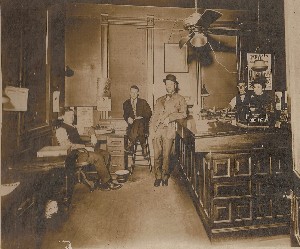 |
Aunt Minie, Office of National Cooperage Co., 1908. A Standard Model B Adding Machine is on the desk at the right. Cooperage companies made wooden casks, kegs, and barrels for beer, wine, whiskey, and other drinks. We do not know the location of this office. In 1900-08 there was a National Cooperage Co. in NY state. In 1912 there was a National Cooperage Co. facility in Brooklyn NY; about the same time there was one in Queens NY. From around 1898 through 1948, there was one in Peoria IL. As of 1922 there was one in Hastings ONT. And at some time in the 20th century there was a plant in Clarendon AR. | Early Office Museum Archives |
 |
This appears to be an accounting office. Seven women on the left are working with ledgers. Two women on the right are typing on book typewriters, most likely made by Elliot-Fisher. In the back of the office are three men and a boy. There is one more man at the right edge of the photo. A candlestick telephone is visible in front of the third woman on the left. | Early Office Museum Archives |
| Office in South Dakota, 1909. | Private collection | |
| Typing department, 1909. | Charles
Babbage Institute, Univ. of Minnesota, Minneapolis, Burroughs Corp. Collection, cb000551. |
|
 |
Office with nine men, five women, and two office boys, photograph by George R. Lawrence Co., New York & Chicago, 1909. This office includes an Automatic check punch, an adding-listing machine, a typewriter, and candlestick telephones. The George R. Lawrence Co. was a prominent Chicago commercial photography firm during the first decade of the 1900s. The company produced many panoramic photographs that are now in the Library of Congress collection. Some of these photos (e.g., a 1906 series of San Francisco after the earthquake and fire) were taken using cameras carried by kites, balloons, and airplanes, and soon after 1910 George R. Lawrence (1869-1938) switched from photography to design and construction of aircraft. The George R. Lawrence Co. also produced indoor photographs, sometimes using an innovative flash lighting system, of very large groups of people, e.g., the Chicago Board of Trade in session, legislatures in session, and large banquets. To see a panoramic photo of Armour's offices in 1900 taken by Geo R. Lawrence Co., click the "Back" button at the top of this page (not the back button on your browser) and look at the photograph at the top of the page of photos from 1900-1903. | Early Office Museum Archive |
| "Interior of the Peoples Bank, Woodhull, Ill.," postcard, postmarked 1909. Photograph includes Oliver typewriter, Burroughs adding machine, date stamp, seal press, and coin machine. | Private collection | |
 |
Farmers and Merchants Deposit Co., Charles Town, WV, postmarked 1909. | Early Office Museum Archives |
| "Office of Capital City Dairy Co., Columbus, OH, Churners of World Famous Purity Butterine," 1909. Capital City's plant opened in 1883. Butterine was oleo-margarine, a butter substitute. In 1900, Capital City Dairy was the largest manufacturer of margarine in the US. | Early Office Museum Archives. |
|
| Click on link at right to see photo. Click the "Back" button on your browser to return here. | Office of "General Sales Agent for the H.O. Company's Algrane Feed," photograph by J. C. Dexter Photo Co., Hartford, CT, 1909. At left is a Gammeter Multigraph printing machine. At center is a front-strike typewriter. | Connecticut History Online |
 |
Office with four women and three typewriters, Berlin, Germany, 1909. The typewriter on the left is a Caligraph. | Early Office Museum Archives |
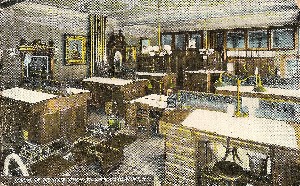 |
Corner of the Main Offices, Wiedemann's, Newport KY, 1909. Two book typewriters are front left. According to Wikipedia, George Wiedemann founded the George Wiedemenn Brewing Company in Newport, KY, outside Cincinnati, OH, in the late 19th century. It became Kentucky's largest brewery. Wiedemann Brewing merged with G. Heileman Brewing Company in 1967. The primary brands were Wiedemann Fine Beer, Royal Amber Beer, Blatz Beer/Cream Ale and other assorted Heileman labels. The brewery was closed in 1983. The Wiedemann name was then sold to the Pittsburgh Brewing Co., which brewed Wiedemann beers until 2007. In 2012, a Newport, KY, company, Geo. Wiedemann Brewing Company, LLC, re-established the brand and started brewing Wiedemann Special Lager as a small-batch, craft beer. | Early Office Museum Archives |
 |
Man in office with Oliver 3 typewriter. | Early Office Museum Archives |
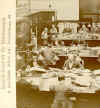 |
Office, Berlin, Germany. | Private collection |
 |
Interior of Highland Bank, Highland, WI. The bank that is now named the Highland State Bank was established in 1903. These two photos were taken from opposite ends of the same room, but not on the same day because a number of items show in the two photos are different. The same man appears on the left of the top photo and the right of the bottom photo. The room contained a Cary walk-in vault, an adding-listing machine, and gas lighting. Internet references to Cary Safe Co. as a seller of safes date primarily to 1902-07. On the counter front right in the bottom photo are a Safety Check Protector (patented 1907-1909) and a Planetary Pencil Pointer (patented 1896 and sold through 1915). | Early Office Museum Archives |
| Woman at a desk with a candlestick telephone, McGill fastener press, and electric ceiling fan. | Early Office Museum Archive |
|
  |
Three offices at the Bank of Peru and London, Lima, Peru. The top photo shows an Oliver typewriter and a Model A Comptometer. The Model A Comptometer was made during 1904-06. The bottom photo shows a front-strike typewriter. | Private collection |
 |
Office in Portland, OR, by the Pacific Photo Co., Portland, OR. This appears to be an accounting office. There are five men and five women. In the foreground are two Model A Comptometers. This model was manufactured during 1904-06. In the background is a Burroughs adding-listing machine. The photograph is by the Pacific Photo Company, Portland, OR. | Early Office Museum Archives |
 |
Office, Pressed Steel Car Co., Pittsburgh, PA. The Pressed Steel Car Company produced steel hopper railroad cars, which were used, for example, to transport coal. The company was founded in 1899 and went out of business in the mid-1950s. | Early Office Museum Archives |
 |
Office, perhaps at a railroad station, with three men, telegraph keys along shelf below windows, Smith Premier typewriter, candlestick and wall telephones, and roll-top desk. | Early Office Museum Archives |
 |
Office with four men and one woman. The woman appears to be working at a frontstrike typewriter. Near three of the men are what appear to be upstrike typewriters, including at least one Remington. This is a divided back postcard and hence dates from 1907 or later. | Early Office Museum Archives |
 |
While men and women are working at similar desks in the center of the office, the women are using typewriters and the men are not. To the immediate left of the column near the front of the photo are a letter copying press and a copying bath. The latter was used to moisten pads used in the letter copying press. | Early Office Museum Archives |
 |
Office of First National Bank, probably in or near Rockwell City, IA. From left to right, office contains a Protectograph check protector on counter, a Burroughs adding machine on stand, a Smith Premier upstrike typewriter next to a frontstrike typewriter on table, a candlestick telephone, a roll-top desk, and another frontstrike typewriter. Above the vault door is the name "First National Bank." | Early Office Museum Archives |
 |
Office with a Burroughs Adding Machine, a map advertising the Empire Coal Co., and a calendar advertising McLeod & Henry Co., Troy, NY. and its "Steel Mixture." McLeod & Henry manufactured boiler door arches and fire box blocks for combustion chambers using its patented "Steel Mixture" material. The combination of an adding machine, one advertisement for coal, and another advertisement for material used in combustion chambers suggests that this photo may show an accounting office at an electrical generating company that burned coal in the combustion chamber of a boiler to produced steam to drive the turbines in an electric generator. | Early Office Museum Archives |
 |
Main Office, Letts-Spencer-Smith Co., Wholesale Grocers, Mason City, IA. Left center a man is using a Burroughs Adding Machine. Center right, behind the partial partition, the red narrow conical speaking tube on a dictating machine is visible. Right, in front of the partial partition, is a wide electric adding-listing machine, probably made by Burroughs Adding Machine Co. Letts-Spencer-Smith built a large warehouse in Mason City in 1909. | Early Office Museum Archives |
 |
Office with 2 men and 3 women. From left there is a roll-top desk, an electric fan, an autographic register, a Protectograph check protector, a candlestick telephone, a Dalton adding machine, two more roll-top desks, and another candlestick telephone. | Early Office Museum Archives |
  |
Top: Office with six men, five of whom are African American, and one woman, who is using an upstrike typewriter. Bottom: Office with two African American men. These magic lantern slides show offices at the interdenominational American Bible Society (ABS), New York, NY, which still exists. Its web site states: "From the American Bible Society's founding in 1816, we have been focused on translation, publication and the distribution of Bibles to as many people as possible. Our mission today is to make the Bible available to every person in a language and format each can understand and afford,..." John Jay, the first Chief Justice of the U.S. Supreme Court, was elected ABS president in 1821. | Early Office Museum Archives. |
 |
Office with a large letter copying press and a basin and wringer for preparing copying pads. In the rear a man is using a wall telephone. | Early Office Museum Archives |
 |
On the left, Hazel Kitt is using a book typewriter, probably one made by Elliott-Fisher, to make entries in a large bound ledger. On the right, Geary L. Foote is reading another large ledger. This photo is a postally unused divided back postcard. | Early Office Museum Archives |
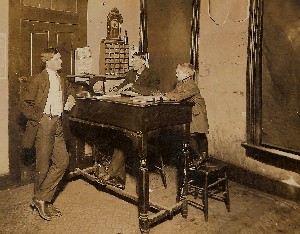 |
Office, Southern Express Company, Calhoun SC, 1909. Prior to the Civil War, the Adams Express Company operated throughout at least the eastern US, delivering mail and packages using the railroads. In 1861, the business of the Adams Express Company in the Confederacy was taken over by a new company -- the Southern Express Company -- which continued to operate after the Civil War. The town of Calhoun, located in the extreme northwest corner of SC, bordered Clemson University and was renamed Clemson in 1943. | Early Office Museum Archives |
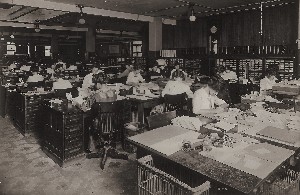 |
Office with 20 women working with small cards, probably in New York, NY. In the background is an addressing machine and behind that are files for the small cards. The small cards may be address stencils used by the addressing machine. In light of the number of cards, this may be an office in a periodical publishing company or a mail order business. | Early Office Museum Archives |
 |
"The
heatless girl loses her job. He told that story, the proud girl was dismissed, And as she turned away away the office loudly hissed." The Theodor Eismann company, Leipzig, Germany, obtained US copyright for this postcard in 1909. This company produced postcards primarily for the US market. This particular card is Theochrom Series No. 1165. |
Early
Office Museum Archives |
 |
Mrs. Harriett Fisher with four employees in an office at her company, Fisher & Norris, Trenton NJ, in 1909. Fisher & Norris was the leading US manufacturer of anvils and vises, which it sold to blacksmiths, railroads, navies, and others around the world. Eagle Anvil Works, Fisher & Norris, 1910 ad. Fisher & Norris was founded by Mark Fisher in Maine in 1843 and moved to Trenton NJ in 1849. It developed a new technology for making anvils and was the first successful anvil producer in the US. It produced more anvils (an estimated 400,000) than any other US company, and produced the largest one, which weighed 1400 lbs. The anvil industry declined in the mid-20th century as other technologies for shaping metal were adopted. In 1979, Fisher & Norris closed. It had produced anvils for 136 years and it outlasted all other anvil producers in the US. After the death of Mark Fisher in 1871 and the death of his partner John Norris the following year, the company passed to Mark’s son Clark, who had served as Chief Engineer of the US Navy during the Civil War. In 1898, 61-year old Clark Fisher married 29-year old Harriet White (1869-1939), who thus became Harriet Fisher. In 1902, the Fishers were in a train derailment. Clark died of his injuries shortly thereafter. Although she had no related training or experience, Harriet quickly mastered every aspect of the anvil business, took over management of Fisher & Norris, and became an exceptionally successful and wealthy business woman. Known as the “Anvil Queen,” she won the contract to provide anvils for construction of the Panama Canal. She owned a 28-room mansion on a 13-acre lot outside Trenton NJ and a villa and yacht on Lake Como in northern Italy, where she spent several months each year. The photo above shows Harriet Fisher in an office at her company in 1909. In 1909-10, Harriet Fisher, her Italian maid, her British butler/cook, her chauffeur, and her dog spent more than a year driving her luxury Locomobile touring car on a challenging trip around the world – through France, across India and SE Asia to China and Japan, and then across the US. This was the first round-the-world trip by a woman in an automobile. After the trip, the maid and butler married and Harriet White Fisher published A Woman’s World Tour in a Motor, Lippincott, Philadelphia, 1911 (https://archive.org/details/womansworldtouri00fish).  Harriet Fisher with Locomobile in Paris In 1912, at forty-three, Mrs. Fisher met and married 29-year old Silvano Alfredo Andrew, an engineer and lieutenant in the Argentine navy who went by the name of Alfredo. Mrs. Fisher, who now used the name Mrs. S. A. Andrew, employed her new husband as a manager at her company. Mrs. Andrew continued to own and manage Fisher & Norris until her death in 1939. Alfredo inherited the Trenton mansion, remarried in 1940, and continued to live in the mansion, as did his son by his second marriage after him. The mansion, known as Reed Manor, was demolished in 2010 to make way for a housing development. A day-and-month calendar on the wall in the office photo indicates that this photo was taken on Friday, April 2. April 2 was a Friday in 1909 and then again in 1915. A 1908 telephone book for the Delaware and Atlantic Telegraph & Telephone Co. is hanging over the side of the desk. A 1908 volume published by Bradstreet’s is standing on the cabinet under the window in the center. These two volumes strongly support a 1909 date for the photo. However, the name along the top of the photo is “Mrs. S. A. Andrew,” which became the woman’s name after her second wedding in 1912. I suspect that the photo was taken in 1909 and that her name was added in 1912 or later. Several items in the photo to the left are worth noting. First, at the top of the wall between the windows are two certificates from the 1876 Philadelphia International Exposition, where Fisher & Norris exhibited its anvils and patent rail joints. The photo immediately below the present text shows the company’s exhibit at the 1876 Exposition. Notice the eagle on top of the 1400 lb. anvil. 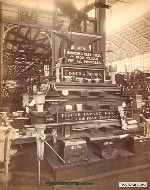 Fisher & Norris Exhibit at 1876 Philadelphia Centennial Exsposition Second, notice that the eagle between the certificates is the same eagle that 33 years before sat atop the 1876 exhibit. Why an eagle? The trademark of Fisher & Norris was an eagle, and the plant was called the Eagle Anvil Works. Third, immediately above the left shoulder of the man under the eagle is a partially hidden image of an anvil. And fourth, certificates near the top of the wall on the right side of the photo are from the 1899 National Export Exposition in Philadelphia, where Fisher & Norris must certainly have exhibited its anvils. Finally, a calendar advertises the Warren Ehret Company, a commercial roofing company founded in 1852 that is still active in the mid-Atlantic region. |
Early Office Museum Archives |
Photographs are copyrighted. All rights are
reserved by the copyright holder, the owner of the photograph, and the Early
Office Museum.
We are interested in purchasing interesting vintage photographs of office
interiors of the types displayed above.